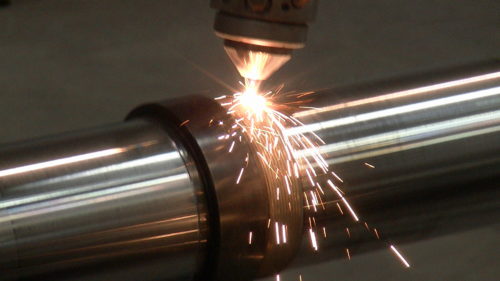 “Hardfacing” and “cladding” are two terms that are often used synonymously, not realizing they are distinctly different applications. If so, you are in good company, as it is a common misconception. Hardfacing is a welding process that applies a high-wear surface to add protection and extend the life of the object. The material welded typically contains carbides and, in most cases, this is tungsten carbide [WC]. Cladding, however, will typically use overlay material that is similar to the base material but in many cases uses a different material to give a beneficial property to just that portion of the component, such a high hardness, corrosion resistance, or just to meet a refurbishing function. As with cladding, laser hardfacing cannot be machined and must be ground.
“Hardfacing” and “cladding” are two terms that are often used synonymously, not realizing they are distinctly different applications. If so, you are in good company, as it is a common misconception. Hardfacing is a welding process that applies a high-wear surface to add protection and extend the life of the object. The material welded typically contains carbides and, in most cases, this is tungsten carbide [WC]. Cladding, however, will typically use overlay material that is similar to the base material but in many cases uses a different material to give a beneficial property to just that portion of the component, such a high hardness, corrosion resistance, or just to meet a refurbishing function. As with cladding, laser hardfacing cannot be machined and must be ground.
Hardfacing vs. Cladding Process
Though hardfacing and cladding are surface overlay processes that are different only in material characteristics that meet different requirements, they both can be achieved using similar processes:
- Lasers
- Thermal spray
- Flux-cored arc welding or FCAW
- Plasma Transfer Arc [PTA] welding
The choice between hardfacing and cladding comes down to the characteristics you want to impart, the materials involved, and an understanding of the environment that the surface is subjected too. In hardfacing, the heavy, wear-resistant carbide/metal deposit can be applied by laser, thermal spraying, spray-fuse, or welding. Thermal spraying is best for items sensitive to heat distortion, as opposed to spray-fuse that requires flame spraying and fusion with a torch. Thermal spray is not a welding process; therefore, bond strength is very low as compared to a welded or brazed overlay. Traditional weld hardfacing can be used to apply a very thick layer (up to 10’s of mm) of wear-resistant material. Laser hardfacing has benefits over the other processes primarily because it is a welding process that has lower heat, lower dilution, and less dissolution of the carbide. This all enables the ability to achieve very thin hardfacing overlays.
Cladding is a weld overlay process yielding an entirely new surface that can be used with a large variety of overlay materials in different forms such as powder, wire, or cored wire. Again, traditional overlay processes can be used as listed above. Just like laser hardfacing, laser cladding has benefits over the other processes primarily because it is a welding process that has lower heat and lower dilution. This all enables the ability to achieve very thin clad overlays.
Laser hardfacing and cladding are used in almost every industry market with applications such as:
- Oil and gas
- Automotive
- Construction equipment
- Agriculture
- Mining
- Military
- Energy generation
- Repair and refurbishment of tools, turbine blades, and engines
Laser hardfacing and laser cladding both provide the advantages of little thermal distortion, high-productivity, and cost effectiveness.
Use of Lasers in Hardfacing and Cladding Processes
Using lasers as a heat source in hardfacing and cladding provides precision and the lowest amount of chemical dilution to weld two materials. It offers a cost-effective way to use less expensive substrate materials by applying a weld overlay, which provides the corrosion, oxidation, wear, and temperature resistance. The high production rate with which products can be completed combined with material cost advantages make laser cladding and hardfacing a popular choice for many industries.
<Learn how Titanova performs laser clad overlays of Cobalt 6 – Stellite® for a variety of clients.>
Cutting-Edge Technology and Industry-Leading Quality
Since 2008, Titanova has been offering full-service laser material processing capabilities, including laser welding, laser cladding, and laser hardfacing, performed in our ISO 9001:2015 certified laser job shop. We are proud to serve a wide variety of industries, from aerospace, nuclear energy, and chemical processing to food processing, steel manufacturing, and transportation. Our experience and expertise in metallurgy, laser processing, and quality assurance provide innovative, cost-effective, and rapid solutions for our customers.
When you need precision laser materials processing with the highest standards in quality for your hardfacing and cladding projects, Titanova is here to help. For more information on our capabilities, or to submit a request for quote, contact us today.

Comments are closed